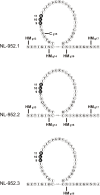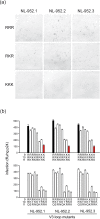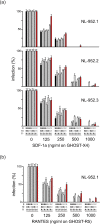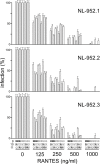Effect of lysine to arginine mutagenesis in the V3 loop of HIV-1 gp120 on viral entry efficiency and neutralization
- PMID: 25785610
- PMCID: PMC4364900
- DOI: 10.1371/journal.pone.0119879
Effect of lysine to arginine mutagenesis in the V3 loop of HIV-1 gp120 on viral entry efficiency and neutralization
Abstract
HIV-1 infection is characterized by an ongoing replication leading to T-lymphocyte decline which is paralleled by the switch from CCR5 to CXCR4 coreceptor usage. To predict coreceptor usage, several computer algorithms using gp120 V3 loop sequence data have been developed. In these algorithms an occupation of the V3 positions 11 and 25, by one of the amino acids lysine (K) or arginine (R), is an indicator for CXCR4 usage. Amino acids R and K dominate at these two positions, but can also be identified at positions 9 and 10. Generally, CXCR4-viruses possess V3 sequences, with an overall positive charge higher than the V3 sequences of R5-viruses. The net charge is calculated by subtracting the number of negatively charged amino acids (D, aspartic acid and E, glutamic acid) from the number of positively charged ones (K and R). In contrast to D and E, which are very similar in their polar and acidic properties, the characteristics of the R guanidinium group differ significantly from the K ammonium group. However, in coreceptor predictive computer algorithms R and K are both equally rated. The study was conducted to analyze differences in infectivity and coreceptor usage because of R-to-K mutations at the V3 positions 9, 10 and 11. V3 loop mutants with all possible RRR-to-KKK triplets were constructed and analyzed for coreceptor usage, infectivity and neutralization by SDF-1α and RANTES. Virus mutants R9R10R11 showed the highest infectivity rates, and were inhibited more efficiently in contrast to the K9K10K11 viruses. They also showed higher efficiency in a virus-gp120 paired infection assay. Especially V3 loop position 9 was relevant for a switch to higher infectivity when occupied by R. Thus, K-to-R exchanges play a role for enhanced viral entry efficiency and should therefore be considered when the viral phenotype is predicted based on V3 sequence data.
Conflict of interest statement
Figures






Similar articles
-
Role of naturally occurring basic amino acid substitutions in the human immunodeficiency virus type 1 subtype E envelope V3 loop on viral coreceptor usage and cell tropism.J Virol. 1999 Jul;73(7):5520-6. doi: 10.1128/JVI.73.7.5520-5526.1999. J Virol. 1999. PMID: 10364300 Free PMC article.
-
Role of the HIV type 1 glycoprotein 120 V3 loop in determining coreceptor usage.AIDS Res Hum Retroviruses. 1999 May 20;15(8):731-43. doi: 10.1089/088922299310827. AIDS Res Hum Retroviruses. 1999. PMID: 10357469
-
[Biological characteristics of HIV-1 isolates circulating in China are linked to its env V3 loop sequence variability].Zhonghua Yi Xue Za Zhi. 2004 Dec 2;84(23):1968-72. Zhonghua Yi Xue Za Zhi. 2004. PMID: 15730807 Chinese.
-
Genotypic coreceptor analysis.Eur J Med Res. 2007 Oct 15;12(9):453-62. Eur J Med Res. 2007. PMID: 17933727 Review.
-
[Sequence variation of HIV and bioinformatics].Uirusu. 2004 Jun;54(1):33-8. doi: 10.2222/jsv.54.33. Uirusu. 2004. PMID: 15449902 Review. Japanese.
Cited by
-
HIV coreceptor tropism determination and mutational pattern identification.Sci Rep. 2016 Feb 17;6:21280. doi: 10.1038/srep21280. Sci Rep. 2016. PMID: 26883082 Free PMC article.
-
Effect of Amino Acid Substitutions Within the V3 Region of HIV-1 CRF01_AE on Interaction with CCR5-Coreceptor.AIDS Res Hum Retroviruses. 2017 Sep;33(9):946-951. doi: 10.1089/AID.2017.0044. Epub 2017 Jun 12. AIDS Res Hum Retroviruses. 2017. PMID: 28497977 Free PMC article.
-
3-Hydroxyphthalic Anhydride- Modified Rabbit Anti-PAP IgG as a Potential Bifunctional HIV-1 Entry Inhibitor.Front Microbiol. 2018 Jun 19;9:1330. doi: 10.3389/fmicb.2018.01330. eCollection 2018. Front Microbiol. 2018. PMID: 29971062 Free PMC article.
References
-
- Berger EA, Doms RW, Fenyö EM, Korber BT, Littman DR, Moore JP, et al. (1998) A new classification for HIV-1. Nature 391: 240 - PubMed
-
- Cocchi F, DeVico AL, Garzino-Demo A, Cara A, Gallo RC, Lusso P (1996) The V3 domain of the HIV-1 gp120 envelope glycoprotein is critical for chemokine-mediated blockade of infection. Nat. Med. 2: 1244–1247. - PubMed
MeSH terms
Substances
LinkOut - more resources
Full Text Sources
Other Literature Sources

